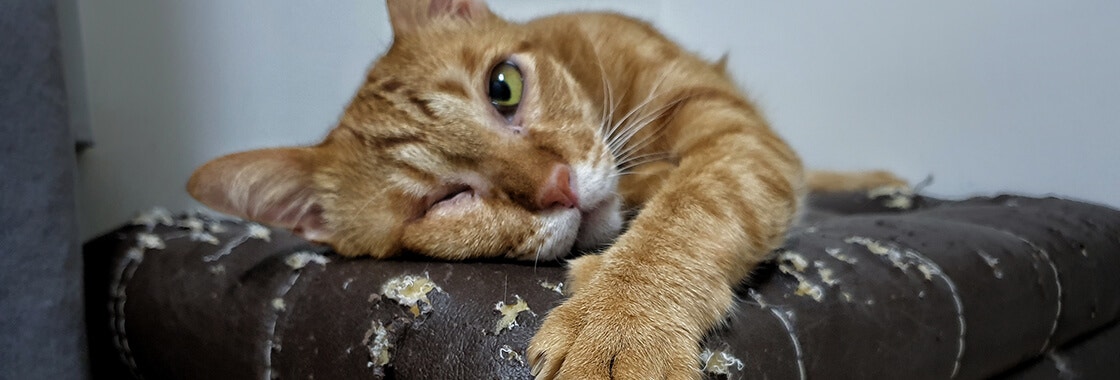- Homepage
- Blog
- Bonding & Care
- Stop Cats From Scratching Furniture
How to stop cats from scratching furniture


Share
As much as we love our cats, an all too common but infuriating behaviour of cats is scratching the furniture. If you’re wondering why cats scratch furniture, it’s because they have a natural inclination to scratch for a number of reasons. Cats scratch to mark their territory, stretch their muscles and maintain their claws. And sometimes, unfortunately, your furniture can be at the receiving end of their scratching.
However, cats scratching furniture can be difficult for cat parents to manage. Besides the cost of damaged furniture, it can take a toll on your relationship with your feline friend. That’s why in this article, we discuss how to stop cats from scratching furniture.The key to stop your cat from scratching furniture is to understand their reasons behind the behaviour and provide better alternatives for their scratching needs.
Why do cats scratch furniture?
Cats love to scratch - and as far as they are concerned, your furniture is not off limits. Scratching is an instinctual behaviour for your cat that offers many benefits to their health and wellbeing. While we can try to stop cats from scratching furniture, cat scratching in the right places should be encouraged.
If you’re wondering how to stop cats scratching furniture or why they want to, below are some common reasons:
- To mark their territory and communicate boundaries to other cats. Scratching allows cats to release pheromones from the scent glands in their paw pads, which leaves behind their individual scent as well as claw husks.
- To make your furniture smell like them. If your furniture smells like your cat, they will feel more comfortable and secure in your home.
- To stretch. Cats tend to stretch before or after their naps, which is important as it helps maintain their flexibility and support their muscle and joint health.
- To remove the outer sheath of their claws. This keeps your cat’s claws healthy and sharp, so they can climb better and defend themselves if necessary.
It may be useful to check out how to stop cats from scratching doors, if this is a specific problem you’re experiencing.
Methods to stop cats from scratching furniture
The best way to stop cats from scratching furniture is to redirect the behaviour by providing appropriate and alternative scratching surfaces around the home. You can place these near certain furniture to stop your cat from scratching it and encourage using the post instead.
It’s important for cat parents to experiment with different types of scratching posts, including vertical and horizontal options, as well as various textures. Depending on the furniture your cat is scratching, your cat may prefer sisal fabric, rope or cardboard posts. For instance, a common solution to stop cats scratching the carpet is to provide a carpet-based scratch post.
If your cat is still scratching furniture, you could also try a deterrent spray on the furniture items your cat is drawn to, which emits an unpleasant scent to avert them. Cats also dislike double-sided tape or aluminium foil because of their texture, so placing this on the furniture may also act as a deterrent.
It’s important to remember that cats aren’t always able to distinguish between what they are allowed and not allowed to scratch. By using positive reinforcement for scratching appropriate surfaces with praise and treats can help them understand.
The importance of cat scratching posts
Scratching posts are extremely important for your cat’s wellbeing, as it provides a suitable area for your cat to fulfil their natural instinct. Depending on the material of the furniture your cat is drawn to, you can provide a post with similar texture as an alternative. This not only protects your furniture, but makes it easier for your cat to relieve their scratching needs in an appropriate manner.
In order to stop cats from scratching furniture, you’ll need to observe their behaviour closely to see when and where they are scratching. This way, you can keep posts close to those areas. Besides the texture, you can also note the height of the item they’re scratching, in case your cat prefers horizontal or vertical surfaces instead.
What home remedy will keep cats from scratching furniture?
There are some home remedies that can stop cats from scratching furniture. For example, cats dislike citrus scents, so using a citrus spray on the furniture in question will act as a natural deterrent. You could also use aluminium foil or double-sided tape, as cats don’t like these textures.
If your cat continues to scratch furniture despite these deterrents, try to thoroughly clean the furniture first. This helps to remove the pheromones your cat has marked on the item, and using deterrent sprays afterwards may be more effective. You can also use commercial deterrent sprays which are stronger in scent.
Can I train my cat not to scratch furniture?
Yes, it’s absolutely possible to train your cat to not scratch furniture. Positive reinforcement is an effective training technique, whereby you can reward your cat with treats and praise when they use an appropriate scratching surface. This will encourage your cat to continue the desired behaviour.
It’s important that cat parents are consistent and patient during the training process, as it can take time to stop cats scratching furniture. Part of caring for a cat is understanding their individual needs, avoiding punishment which can make things worse, and utilising positive reinforcement for desired behaviours.
Keeping harmony with your cat companion
Although it is frustrating and upsetting when furniture is damaged, remember that cat scratching furniture is a natural behaviour - your cat is not deliberately trying to cause this (but it might be helpful to learn how to get a cat to like you, just in case). With alternative scratching outlets, positive reinforcement training and natural and commercial deterrents, you’ll be able to stop your cat from scratching furniture.
As long as you remain patient and consistent, you’ll be able to meet your cat’s needs while keeping your furniture safe, which will in turn improve your relationship together. If you ever find yourself moving house with a cat, make sure to check out our guide to keep the process smooth, your cat comfortable and destructive coping mechanisms at bay.



